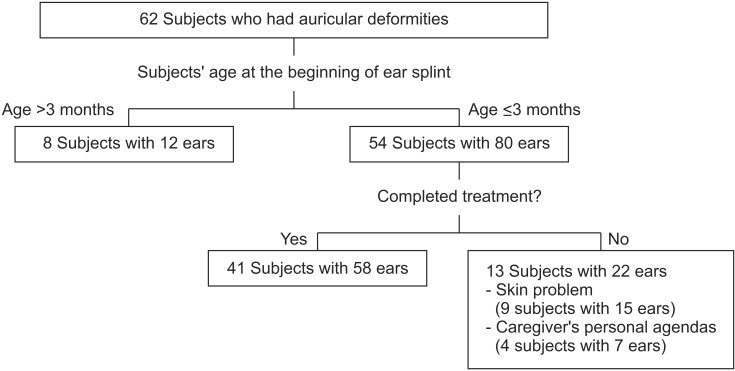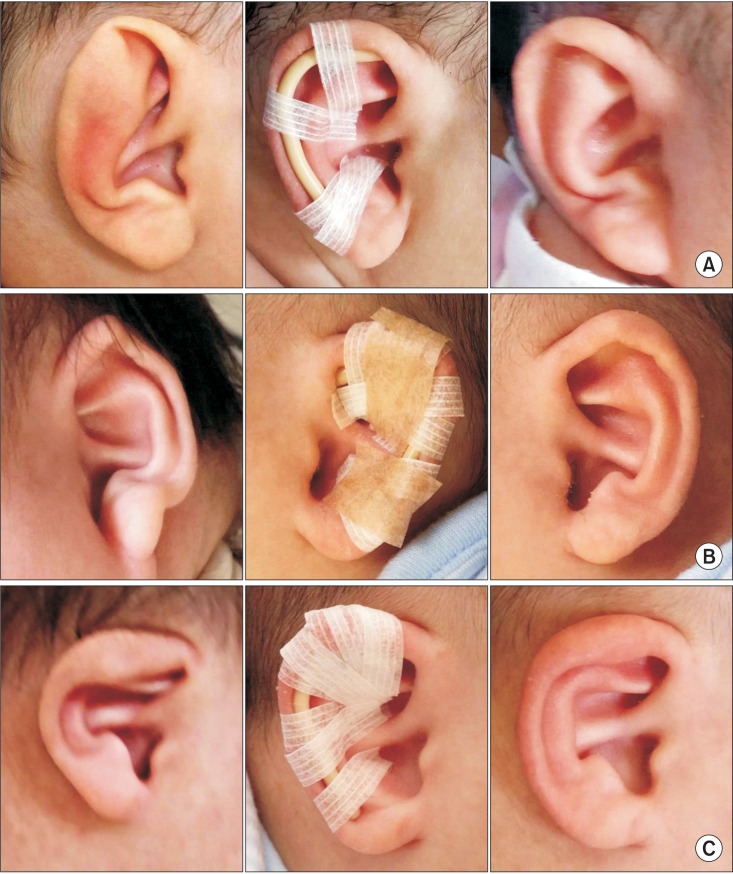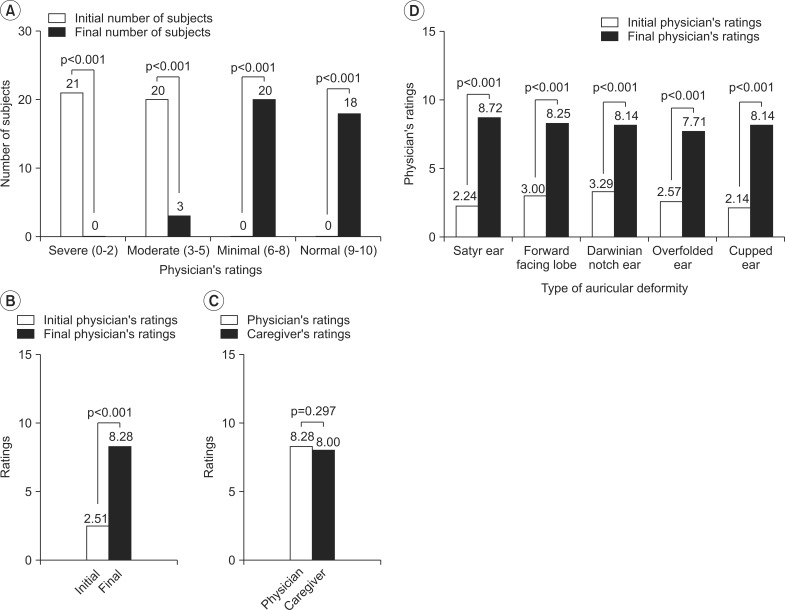Ann Rehabil Med.
2017 Feb;41(1):138-147. 10.5535/arm.2017.41.1.138.
Effectiveness of Ear Splint Therapy for Ear Deformities
- Affiliations
-
- 1The Center for Torticollis, Department of Physical Medicine and Rehabilitation, Ajou University School of Medicine, Suwon, Korea. syyim@ajou.ac.kr
- KMID: 2383688
- DOI: http://doi.org/10.5535/arm.2017.41.1.138
Abstract
OBJECTIVE
To present our experience with ear splint therapy for babies with ear deformities, and thereby demonstrate that this therapy is an effective and safe intervention without significant complications.
METHODS
This was a retrospective study of 54 babies (35 boys and 19 girls; 80 ears; age ≤3 months) with ear deformities who had received ear splint therapy at the Center for Torticollis, Department of Physical Medicine and Rehabilitation, Ajou University Hospital between December 2014 and February 2016. Before the initiation of ear splint therapy, ear deformities were classified with reference to the standard terminology. We compared the severity of ear deformity before and after ear splint therapy by using the physician's ratings. We also compared the physician's ratings and the caregiver's ratings on completion of ear splint therapy.
RESULTS
Among these 54 babies, 41 children (58 ears, 72.5%) completed the ear splint therapy. The mean age at initiation of therapy was 52.91±18.26 days and the treatment duration was 44.27±32.06 days. Satyr ear, forward-facing ear lobe, Darwinian notch, overfolded ear, and cupped ear were the five most common ear deformities. At the completion of therapy, the final physician's ratings of ear deformities were significantly improved compared to the initial ratings (8.28±1.44 vs. 2.51±0.92; p<0.001). There was no significant difference between the physician's ratings and the caregiver's ratings at the completion of ear splint therapy (8.28±1.44 vs. 8.0±1.61; p=0.297).
CONCLUSION
We demonstrated that ear splint therapy significantly improved ear deformities in babies, as measured by quantitative rating scales. Ear splint therapy is an effective and safe intervention for babies with ear deformities.
Keyword
MeSH Terms
Figure
Reference
-
1. Hunter A, Frias JL, Gillessen-Kaesbach G, Hughes H, Jones KL, Wilson L. Elements of morphology: standard terminology for the ear. Am J Med Genet A. 2009; 149A:40–60. PMID: 19152421.
Article2. Bartel-Friedrich S, Wulke C. Classification and diagnosis of ear malformations. GMS Curr Top Otorhinolaryngol Head Neck Surg. 2007; 6:Doc05. PMID: 22073081.3. Smith W, Toye J, Reid A, Smith R. Nonsurgical correction of congenital ear abnormalities in the newborn: case series. Paediatr Child Health. 2005; 10:327–331. PMID: 19675840.
Article4. Matsuo K, Hayashi R, Kiyono M, Hirose T, Netsu Y. Nonsurgical correction of congenital auricular deformities. Clin Plast Surg. 1990; 17:383–395. PMID: 2189652.5. Kuo AA, Tritasavit S, Graham JM Jr. Congenital muscular torticollis and positional plagiocephaly. Pediatr Rev. 2014; 35:79–87. quiz 87. PMID: 24488831.
Article6. Kurozumi N, Ono S, Ishida H. Non-surgical correction of a congenital lop ear deformity by splinting with Reston foam. Br J Plast Surg. 1982; 35:181–182. PMID: 7082894.
Article7. Leonardi A, Bianca C, Basile E, Ungari C, Arangio P, Filiaci F, et al. Neonatal molding in deformational auricular anomalies. Eur Rev Med Pharmacol Sci. 2012; 16:1554–1558. PMID: 23111969.8. Byrd HS, Langevin CJ, Ghidoni LA. Ear molding in newborn infants with auricular deformities. Plast Reconstr Surg. 2010; 126:1191–1200. PMID: 20453717.
Article9. Schonauer F, La Rusca I, Molea G. Non-surgical correction of deformational auricular anomalies. J Plast Reconstr Aesthet Surg. 2009; 62:876–883. PMID: 18490209.
Article10. Sorribes MM, Tos M. Nonsurgical treatment of prominent ears with the Auri method. Arch Otolaryngol Head Neck Surg. 2002; 128:1369–1376. PMID: 12479722.
Article11. US Food and Drug Administration. EarWell ear correction splint [Internet]. Silver Spring: US Food and Drug Administration;c2017. cited 2017 Jan 7. Available from: http://www.accessdata.fda.gov/scripts/cdrh/cfdocs/cfrl/ldetails.cfm?lid=263752.12. van Wijk MP, Breugem CC, Kon M. A prospective study on non-surgical correction of protruding ears: the importance of early treatment. J Plast Reconstr Aesthet Surg. 2012; 65:54–60. PMID: 21903493.
Article13. Park C. Correction of cryptotia using an external stretching device. Ann Plast Surg. 2002; 48:534–538. PMID: 11981196.
Article14. Park JH, Kim KM, Lee YS, Kim YS, Kim YO. Nonoperative correction of congenital auricular deformities using a silicone splint. J Korean Soc Plast Reconstr Surg. 2000; 27:532–538.15. Paul-Dauphin A, Guillemin F, Virion JM, Briancon S. Bias and precision in visual analogue scales: a randomized controlled trial. Am J Epidemiol. 1999; 150:1117–1127. PMID: 10568628.
Article16. McCormack HM, Horne DJ, Sheather S. Clinical applications of visual analogue scales: a critical review. Psychol Med. 1988; 18:1007–1019. PMID: 3078045.
Article17. Streiner DL, Norman GR. Health measurement scales: a practical guide to their development and use. 4th ed. New York: Oxford University Press;2008.18. Tan S, Wright A, Hemphill A, Ashton K, Evans J. Correction of deformational auricular anomalies by moulding: results of a fast-track service. N Z Med J. 2003; 116:U584. PMID: 14581967.19. van Wijk MP, Breugem CC, Kon M. Non-surgical correction of congenital deformities of the auricle: a systematic review of the literature. J Plast Reconstr Aesthet Surg. 2009; 62:727–736. PMID: 19328756.
Article20. Fraser L, Starritt N, Melia L, Kubba H. Development of a screening service for neonatal ear deformity using neonatal hearing screeners and an information leaflet. Int J Pediatr Otorhinolaryngol. 2013; 77:538–543. PMID: 23411133.
Article21. Yotsuyanagi T. Nonsurgical correction of congenital auricular deformities in children older than early neonates. Plast Reconstr Surg. 2004; 114:190–191. PMID: 15220591.
Article22. Doft MA, Goodkind AB, Diamond S, DiPace JI, Kacker A, LaBruna AN. The newborn butterfly project : a shortened treatment protocol for ear molding. Plast Reconstr Surg. 2015; 135:577e–583e.




